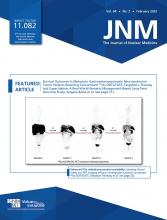Osteosarcoma is a malignant bone tumor with very limited therapeutic options (1). However, targeting the frequently overexpressed disialoganglioside GD2 was successful in preclinical studies with bispecific GD2 antibodies (2), and a clinical trial is ongoing using the clinically approved GD2 antibody dinutuximab in osteosarcoma patients (NCT02484443). Recently, we developed the radiolabeled antibody [64Cu]Cu-DOTAGA-ch14.18/CHO to evaluate GD2 expression by PET (3).
Here, we assessed the in vivo GD2 expression in a heavily pretreated woman with progressive pulmonary osteosarcoma metastasis for potential therapy stratification (compassionate use according to German Medicinal Products Act AMG §13.2b). PET/MRI was performed 19 h after injection of 234 MBq of [64Cu]Cu-NOTA-ch14.18/CHO and revealed increased tracer retention with a high signal-to-background ratio bilaterally in the pulmonary metastases (SUVmax, 9.8; Fig. 1). The background uptake in normal lung tissue and blood pool was reasonably low, whereas retention in the liver was relatively high. An intense GD2 expression was confirmed in a resected pulmonary metastasis by GD2 immunohistochemistry and by cyclic immunofluorescence staining.
(A) Maximum-intensity projection (left) and representative transaxial slices (right) of [64Cu]Cu-NOTA-ch14.18/CHO-PET/MRI. (B) Hematoxylin and eosin staining. (C) GD2 immunochemistry. (D) Cyclic immunofluorescence staining of resected pulmonary osteosarcoma metastasis.
To the best of our knowledge, we present here the first report of clinical GD2 PET/MRI in an osteosarcoma patient with pulmonary metastasis. Our findings demonstrate that GD2 expression can be assessed noninvasively in vivo using [64Cu]Cu-NOTA-ch14.18/CHO-PET/MRI, which might open new possibilities for therapy stratification in GD2-expressing tumor entities such as osteosarcoma or melanoma.
DISCLOSURE
This work was supported by the Deutsche Forschungsgemeinschaft (DFG, German Research Foundation, Germany’s Excellence Strategy EXC2180-390900677). No other potential conflict of interest relevant to this article was reported.
Footnotes
Published online Sep. 15, 2022.
- © 2023 by the Society of Nuclear Medicine and Molecular Imaging.
- Received for publication July 19, 2022.
- Revision received July 29, 2022.








